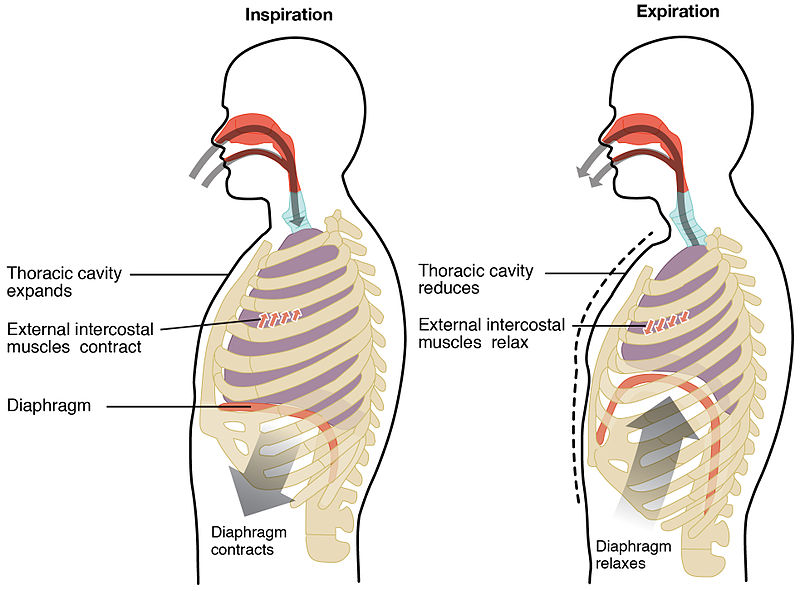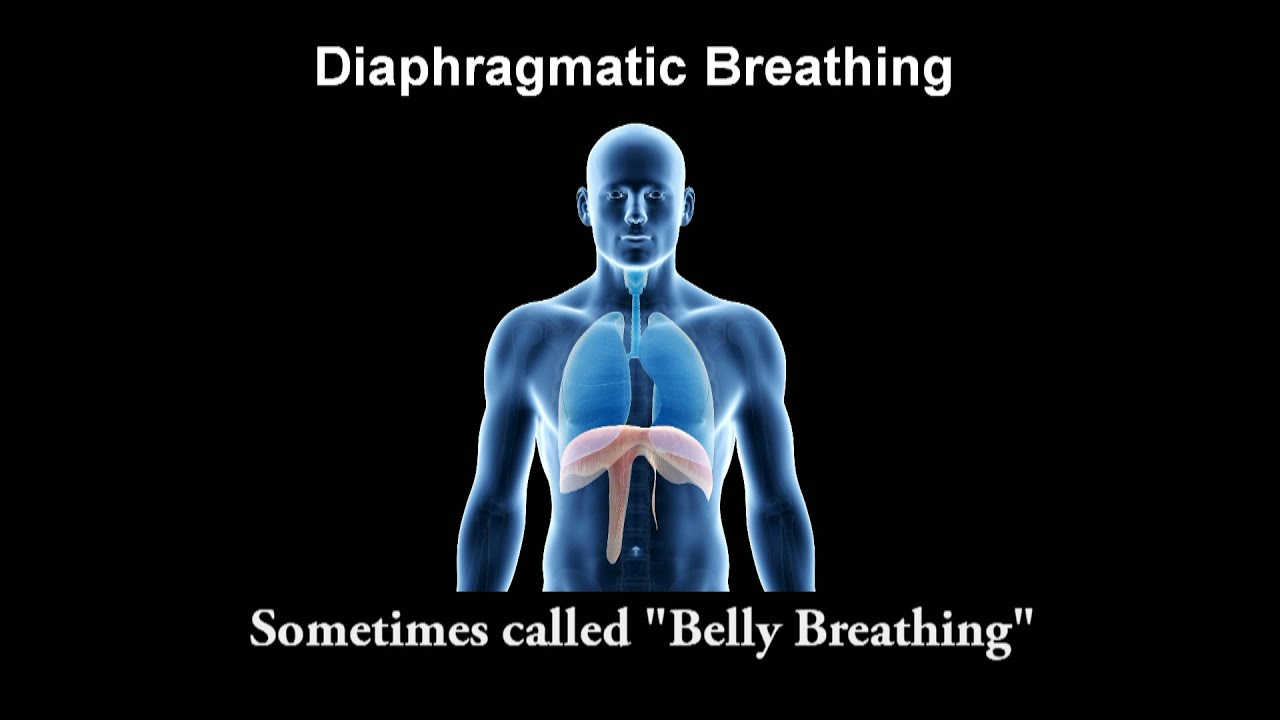Updated June 23, 2023
Do you want to feel energetic and improve your general health? Take a moment to focus on your breathing. Do you breathe through your mouth or nose? Do you feel gasping for air or calm and comfortable?
How we breathe can make a profound difference to us, no matter whether we are ordinary people, elite athletes, or asthmatics. We humans can live without food for 3 weeks, without water for 3 days, but without breathing we can hardly pass for 3 minutes.
Yet, most of us take breathing for granted and don’t pay much attention to how we breathe. It turns out that the breath from many of us is normally fast and shallow, while for some is gentle and effortless, and these different ways of breathing could make a dramatic impact on your health and well-being.

On the in-breath, push your diaphragm down and your belly out; on the out-breath, pull your diaphragm up and your belly in.
(Image by OpenStax College)
Breathing mechanics
In a breathing cycle, the lungs can be expanded and contracted in two ways. One is by lengthening and shortening the chest cavity (up and down) and the other is by increasing and decreasing the chest diameter (front and back).
The first way is mainly performed by the diaphragm which is located between the chest cavity and the abdomen. The diaphragm is the primary breathing muscle that is designed to perform the majority of the breath work. It is a dome-shaped large sheet of muscle that moves down to draw air during inhalation and moves up to expel air during exhalation in a fashion like a diaphragm pump. Breathing in this way is called diaphragmatic breathing, during which the abdomen moves in and out while the chest is hardly moving. Diaphragmatic breathing is often combined with nose breathing. Because diaphragmatic breathing draws air deep into the lungs, it is also called Deep Breathing, where the word ‘Deep’ is meant to indicate deep into the lungs and not necessarily big in volume.
The second way is through the chest / intercostal muscles in the chest wall between the ribs, where the intercostal muscles contract to draw air in and relax to expel air out. Breathing in this way is called chest breathing, during which the chest moves in and out. Chest breathing is often combined with mouth breathing. Because chest breathing does not draw air deep into the lungs, it is also called Shallow Breathing, and it normally draws more air than your metabolic needs.

Comparison between Diaphragmatic and Chest Breathing
Among many, one of the key advantages of diaphragmatic breathing over chest breathing is its much higher efficiency for oxygen intake. The following summarizes the rationale:
-
- The diaphragm draws air passing the bottom of the lungs, allowing air to make full contact with the lower part of the lungs, whereas, in chest breathing, the air hardly passes down to the lower parts of the lungs, which in most situations contains more blood due to gravity. Therefore, for the same volume of air, more oxygen can be diffused to the blood via the lungs when the diaphragm is engaged.
- Diaphragm is one large piece of thin muscle, and once worked in sync with the abdomen muscles, can sustain long-lasting powerful breathing than the chest muscles. The pumping movement of the diaphragm is a much better mechanics than the intercostal muscles lifting the chest ribs as far as air moving is concerned.
- The diaphragm moves slower and draws less air compared with chest breathing which could draw a larger amount of air quickly, making it easily cause hyperventilation or over-breathing, which is harmful to health.
- Due to the dead space in the airway between the nose and the lungs, when inhaling the same total amount of air in a minute from the nose, more air will be reached the lungs with slower but deeper diaphragmatic breathing than faster and shallow chest breathing.
- Another very important factor that most of us are not aware of is the fact that fast and shallow chest breathing tends to get rid of too much CO2 in the lungs and in the blood, where medical science has proven that when the CO2 level is too low in the lungs, it would create the condition to cause asthma; and when it is too low in the blood, it will limit the oxygen to get released from haemoglobins when the blood traveling to the brain, organs, and tissues throughout the body. So, if you are asthmatic, chest breathing is more likely to trigger asthma than diaphragmatic breathing; and if you are doing sports, prolonged chest breathing will get you fatigued earlier than diaphragmatic breathing due to less oxygen released to tissues and muscles.
Other than being an efficient way to breathe, diaphragmatic breathing also has other health benefits, such as:
-
- Makes you calm and relaxed.
- Lower your heart rate.
- Help lower your blood pressure.
- Help maintain a good posture and core stability.
- Help achieve effective lymphatic drainage for improving the immune system.

Having said all the advantages of diaphragmatic breathing, chest breathing is here for a reason. Typically, we may breathe through the chest in situations and events that require a sudden and fast increase in oxygen intake, such as in certain sports requiring a shot burst of breathing, or in certain ‘Fight and Flight’ situations.
Other than these fewer common situations, diaphragmatic breathing via the nose has been proven to be the most efficient and healthiest way in which humans should breathe most of the time. Proper diaphragmatic breathing will make you feel energetic, and it could make profound benefits for your general health as opposed to chest breathing via the mouth, which is harmful to health if breathing like that most of the time. However, in the modern day, most of us more or less do chest breathing, and it is a habit that has been with us for a long time. There are many breathing exercises that could be used for practicing diaphragmatic breathing via the nose.
Understandably, for many, it would require significant time and effort to make diaphragmatic breathing via the nose a new habit. Apart from being persistent, certain breathing devices could help practice and master the technique easier and quicker. Aimwell AYO BT Breathing Trainer and Breathing Exerciser is one of these devices on offer, which is designed to train you to breathe with the diaphragmatic via the nose naturally – the first step you must take to gain better health.
